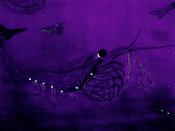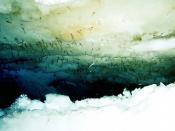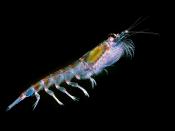Krill
If you were to combine all of their weight together, it would definitely out weigh the entire human race (Cordell Bank). These tiny shrimp like crustacians are called krill. Thousands of krill, packed together swim through the ocean like a swarm of bees. Krill sometimes make the ocean appear to be a slight pinkish color because of their vast and dense population. The animals most commonly depicted in books and webpages are artic animals like the whale, seal, and penguins however krill play a very vital role in Antarctica's ecosystem.
The Euphausiid shrimp or more commonly known as Krill are hatched from free floating eggs. As krills grow older they cast off their rigid outer skeleton in a process called a molt. While their new skeleton is still soft they can grow to a larger size, however if food sources are scarce then the krill can actually shrink to compensate the low food supply.
There are about 85 different species of krill ranging in size from 1cm to 14cm (Enchanted Learning 2003). The most dominate krill in the southern polar oceans are called Euphausia superba, and they grow to as large as 6cm and weigh about a gram. Krills have legs called swimmerets which act as gills for them. When krills swim their front legs strain food from the water as they swim (Cordell Bank). Krill eat phytoplankton; single-celled plants that hang out near the top of the ocean. The krill spends most of it's time deep in the ocean (100m) away from predators. At night krill will swim to the top to feed. Unlike most of god's creatures, krill can fast for up to 200 days, shrinking at this time.
So many different species depend on krill to eat. Krill are the transition from the primary producer to...



Wow
You included alot of Information on the species. Not bad.
2 out of 3 people found this comment useful.